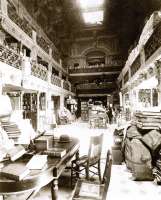In this essay, I join others who have critiqued the naturalization of authorship and the transformation of copyright into an intransigent category, but I do so by examining the architecture of the new building of the Library of Congress, constructed to the east of the Capitol from 1886 to 1897. I focus on the book stacks that were constructed at the core of the Beaux-Arts structure, the catalogues (and catalogues of catalogues) that were built in it soon thereafter, and the shelves and drawers this equipment accommodated—in short, the physical assemblage of equipment that structured the library as what we would today call a database.
This architecture did not merely make it possible, in chief librarian Ainsworth Rand Spofford’s words, to “follow out the record of any individual copyright, and thus to trace questions concerning literary property.” It also had a transformative effect on authorship: the operations carried out inside the building thanks to this architecture—especially operations carried out by the Government Printing Office and the Card Division—caused intellectual property to function in a new manner in the United States in the twentieth century. In this sense, this is also a story about a little-discussed aspect of databases, an arrangement that is narrowly associated today with the rise of computational technologies: that they are not merely records of the world but have the power to reorganize it.
TO ACCESS THE FULL TEXT, PLEASE CLICK THE “DOWNLOAD PDF” LINK.


